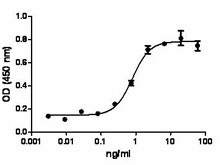- Regulatory Status
- RUO
- Other Names
- Cytotoxic T-lymphocyte-associated antigen 8, cytotoxic T-lymphocyte-associated serine esterase 8, Ctla8, Ctla-8, Il17a, Il17

-

Mouse IL-6 induced by mIL-17A in fetal mouse skin fibroblasts.
| Cat # | Size | Price | Quantity Check Availability | ||
|---|---|---|---|---|---|
| 576002 | 10 µg | $147.00 | |||
| 576004 | 25 µg | $265.00 | |||
| 576006 | 100 µg | $586.00 | |||
| 576008 | 500 µg | $1758.00 | |||
IL-17A was initially identified from a subtracted cDNA library between closely related murine lymphoid cells and called CTLA-8. IL-17A shares 58% homology with an open reading frame of the T-lymphotropic Herpes virus Samirii virus (viral IL-17). IL-17A belongs to a family of cytokines, which has five members; designated IL-17A-F. IL-17 is expressed by a unique lineage of CD4 T cells, Th17 cells. This lineage selectively produces proinflammatory cytokines including IL-17, IL-17F, IL-21, and IL-22. In the mouse, the differentiation of this new lineage is initiated by TGFbeta-1 and IL-6 or IL-21, which activates Stat3 and induces the expression of the transcription factor retinoic acid-related orphan receptors (RORγt and RORα). IL-23, which also activates Stat3, serves to maintain Th17 cells lineage.
Product Details
- Source
- Mouse IL-17A, amino acids Ala26-Ala158 (Accession # NM_010552) was expressed in E. coli.
- Molecular Mass
- The 133 amino acid recombinant protein has a predicted molecular mass of 14,978 Da. This protein exists as a disulfide-linked homodimer. The DTT-reduced protein migrates at approximately 15kDa by SDS-PAGE. The non-reduced protein migrates as a homodimer, at approximately 28kDa by SDS-PAGE.
- Purity
- Purity is >98%, as determined by Coomassie stained SDS-PAGE.
- Formulation
- 0.22 µm filtered protein solution is in 10 mM NaH2PO4, 0.15 M NaCl, pH 7.2.
- Endotoxin Level
- Endotoxin level is <0.1 EU/µg (<0.01 ng/µg) protein as determined by the LAL method.
- Concentration
- 10 and 25 µg sizes are bottled at 200 µg/mL. 100 µg size and larger sizes are lot-specific and bottled at the concentration indicated on the vial. To obtain lot-specific concentration and expiration, please enter the lot number in our Certificate of Analysis online tool.
- Storage & Handling
- Unopened vial can be stored between 2°C and 8°C for up to 2 weeks, at -20°C for up to six months, or at -70°C or colder until the expiration date. For maximum results, quick spin vial prior to opening. The protein can be aliquoted and stored at -20°C or colder. Stock solutions can also be prepared at 50 - 100 µg/mL in appropriate sterile buffer, carrier protein such as 0.2 - 1% BSA or HSA can be added when preparing the stock solution. Aliquots can be stored between 2°C and 8°C for up to one week and stored at -20°C or colder for up to 3 months. Avoid repeated freeze/thaw cycles.
- Activity
- The ED50 is 0.25 - 1 ng/ml, corresponding to a specific activity 1.0 - 4 x 106 units/mg, as determined by a dose dependent stimulation of fetal mouse skin fibroblasts production of IL-6.
- Application
-
Bioassay
- Recommended Usage
-
Use when high specific biological activity is required.
- Application Notes
-
BioLegend carrier-free recombinant proteins provided in liquid format are shipped on blue-ice. Our comparison testing data indicates that when handled and stored as recommended, the liquid format has equal or better stability and shelf-life compared to commercially available lyophilized proteins after reconstitution. Our liquid proteins are verified in-house to maintain activity after shipping on blue ice and are backed by our 100% satisfaction guarantee. If you have any concerns, contact us at tech@biolegend.com.
- Additional Product Notes
-
View more applications data for this product in our Scientific Poster Library.
-
Application References
(PubMed link indicates BioLegend citation) - Product Citations
-
Antigen Details
- Structure
- Cytokine
- Distribution
-
IL-17A is largely produced by activated memory T lymphocytes, CD4+ T helper cells (Th17), neutrophils, CD8(+), NK, and gamma-delta T cells. IL-17AR is expressed in epithelial cells, fibroblasts, B and T lymphocytes, myelomonocytic cells, and marrow stromal cells.
- Function
- IL-17A is a potent regulator of granulopoiesis and neutrophil recruitment under normal and inflammatory conditions. Organ overexpression of IL-17A increases circulating neutrophil numbers and recruitment into the organs by induction of CXCL2, IL-1β, and G-CSF. IL-17A induces CXCL1, CXCL2, CXCL5, and CXCL8 in human epithelial cells. IL-17A also cooperates with TLR ligands, IL-1 beta, and TNF alpha to enhance inflammatory reactions and stimulate production of beta-defensins and other antimicrobial peptides. Th17 differentiation of human and murine naïve T cells is markedly suppressed in the presence of IFNα.
- Bioactivity
- IL-17A signals through a heteromeric receptor composed of IL-17RA and IL-17RC.
- Biology Area
- Cell Biology, Immunology, Neuroinflammation, Neuroscience
- Molecular Family
- Cytokines/Chemokines
- Antigen References
-
1. Yu J, et al. Front Biosci 13:170-177 2008.
2. Toy D, et al. J. Immunol. 177:36-39 2006.
3. Benghiat FS, et al. Transplant Rev 23:11-18 2009.
4. Honorati MC, et al. Rheumatology 40:522-527 2001.
5. Rouvier E, et al. J. Immunol. 150:5445-5456 1993.
6. Liang SC, et al. J. Immunol. 179:7791-7799 2007.
7. Ouyang W, et al. Immunity 28:454-467 2008. - Gene ID
- 16171 View all products for this Gene ID
- UniProt
- View information about IL-17A on UniProt.org
